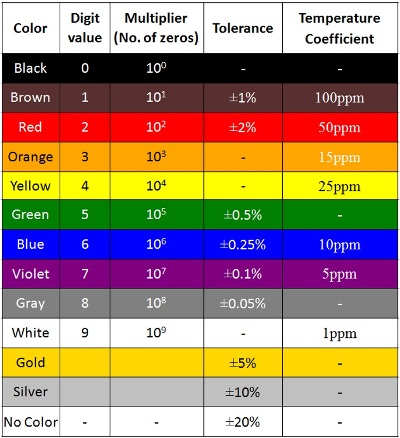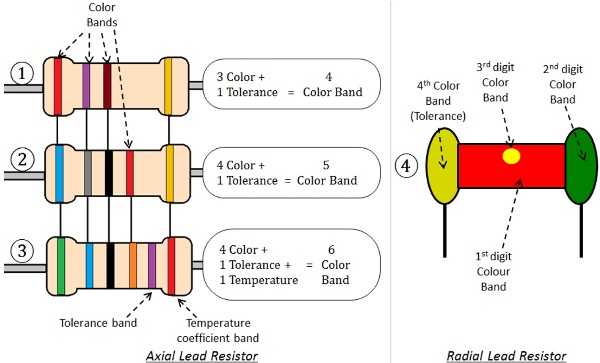We know from our previous post that what is is resistor? This article is about how to calculate resistor value using color code. When comes to measure the value of resistor we can do that by several ways. One way is to use Multimeter. But one can also read value of resistor by using Color Code Menthod (in case of through hole type) or simply by having reference of Number Marking (in case of surface mount type). I assume you probably have used multimeter in your school. So we are going to color code method in detail.
Color Coding in Resistors
In through hole resistors, resistance is caluclated by color bands marked on their body. The color bands present on resistors may vary from 4 to 6. The meaning (value) of these color bands is listed below .This table can be referred for calculating value of axial as well as radial lead type through hole resistors.

The following picture shows position of color bands on axial and radial lead type resistors.

In case of axial lead resistors, the reading direction of color band can be selected from observation as,
- The position of 1st band is closest to lead and there is a space between color value band and tolerance band. This method will work for almost all type of axial lead resistors
- The most accurate method is to follow manufacturer’s documentation (e.g. datasheet)
The picture below shows four different resistors. Each of these, resistor have different color bands. Their resistance value is calculated as follows.

Important to Note
- Tolerance means percentage error in value of resistance.
- Temperature coefficient of resistance (TCR): This band is for specialized resistors. It is change in resistance per degree celcius of temperature change. For a change of 10oC in temperature the resistance can change for 0.1%. Unit is ppm/0c (parts per million per degree centigrade)
- Exception to color bands: In military equipments extra color band (Reliability band) on resistors specifies failure rate (in %) per 1000 Hrs of service. The failure rate for different colors is, Brown – 1%, Red – 0.1%, Orange – 0.01%, Yellow – 0.001%. Resistor having only single black band is called as zero-ohm resistor. It is used as a wire ( act as a jumper) to connect traces on a printed circuit board (PCB).
This is it for this post, I believe now you know how to calculate resistor value using color code. There is a lot we can write and argue, because of such a vast topic but I leave it here. In next post, we’ll learn about use of pull-up and pull-down Resistor in electronic circuit.
 BINARYUPDATES.COM EMBEDDED SYSTEMS TRAINING
BINARYUPDATES.COM EMBEDDED SYSTEMS TRAINING